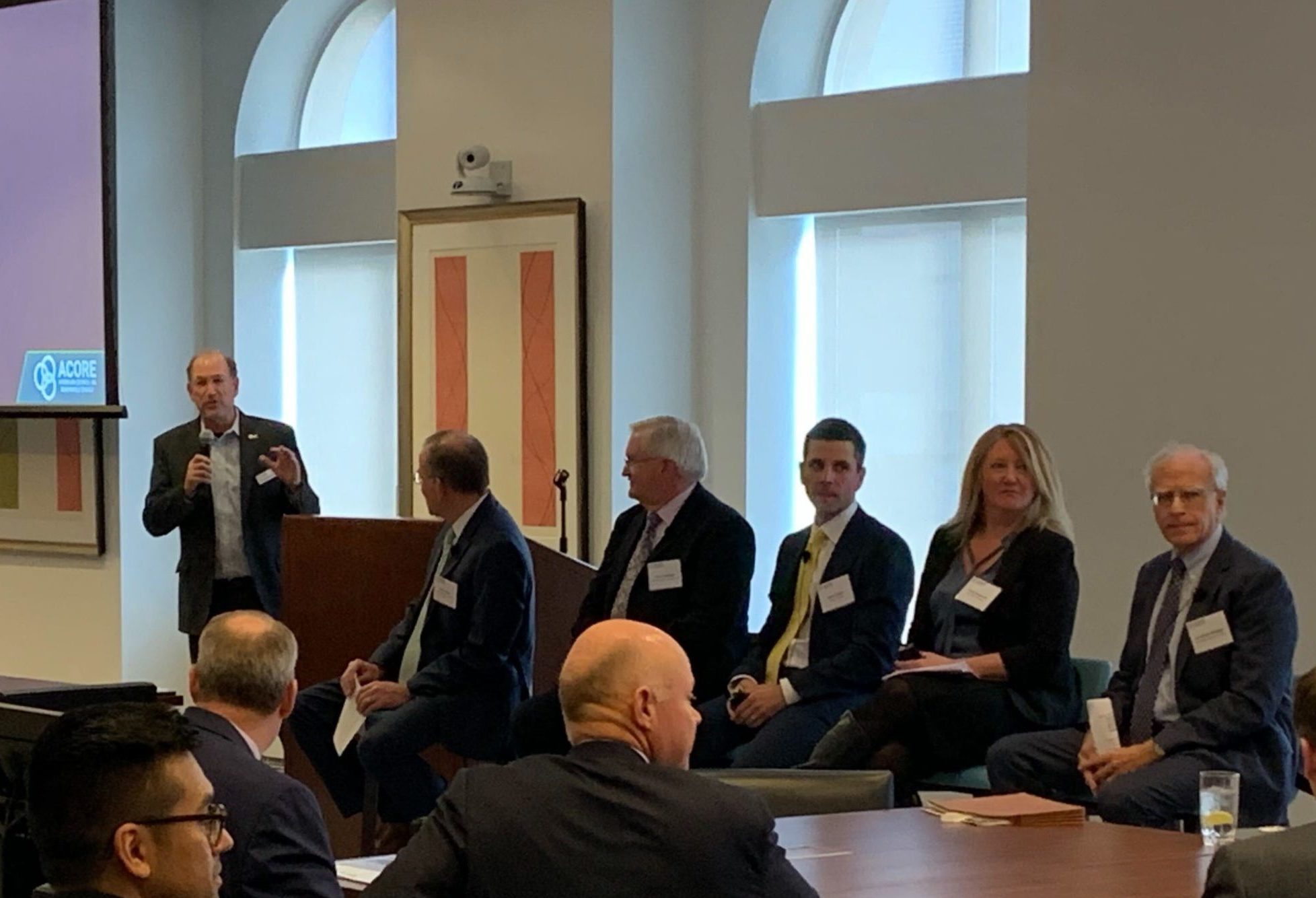- Grid Infrastructure
- Renewable Energy Innovation
- Siting & Permitting Reform
- Tax Incentives & Appropriations
- Transmission & Power Markets
- Blog
Examining Priorities for Transmission and Renewable Integration
April 10, 2020
By: Tyler Stoff
This post follows Part 1, Assessing the Impact of FERC’s MOPR and BSM Decisions on Wholesale Markets, which was released earlier this month.
In early March, ACORE members joined an Executive Meeting in Washington, D.C. ahead of the 2020 ACORE Policy Forum to assess the effects of emerging power and integration issues on renewable growth. The meeting included a priority-setting discussion on approaches for U.S. transmission buildout to accommodate higher levels of renewable energy. ACORE’s recent white paper, Advancing America’s Climate Leadership, which identified transmission expansion as a necessary measure for readying the grid for greater renewable energy penetration, helped inform the conversation.

Speakers from Skadden Arps, RWE Renewables Americas, Pattern Energy, kW Energy Strategies and Berkshire Hathaway Energy began the panel by making the case for expanded transmission to support the growing market demand for renewable power. Transmission lines connect centers of high renewable resources with centers of high electric demand, like cities. Upgrading America’s transmission system is a cost-effective way to alleviate transmission congestion and allow the integration of new renewable energy, which is expanding rapidly due to competitive prices, corporate procurement goals and state renewable energy standards.
Panelists identified siting, permitting and financing the high capital cost of new assets as the largest obstacles to these necessary transmission upgrades. Unlike the federal permitting process for natural gas pipelines, transmission lines are permitted at state and local levels, which can make approvals complex as different jurisdictions judge proposals independently. One panelist said they spent 11 years seeking a permit simply to begin construction on a transmission line. Many projects also struggle to allocate costs appropriately among beneficiaries.
While transmission constraints are not a new concern, panelists noted that previous policy reforms have fallen short in addressing the primary issues. For example, the Energy Policy Act of 2005 attempted to solve siting concerns, but the language never awarded federal regulators the authority necessary to federalize the process. To ease barriers for building transmission lines between regions of the country, the Federal Energy Regulatory Commission (FERC) established an interregional planning process when it issued Order No. 1000 in 2011. Nine years later, this framework has still not led to the intended development of new interregional projects.
Panelists highlighted legislative proposals in Congress to correct faults in the planning process, such as an interregional planning bill introduced by Sen. Martin Heinrich (D-NM), but acknowledged that even these measures would be insufficient. They further hoped for reform to project siting and permitting through updates to the National Environmental Policy Act (NEPA). While the White House’s planned NEPA reforms are already underway, panelists drew attention to the need for guaranteed timelines, inter-governmental coordination, and greater outreach with local NGOs as necessary baselines for more successful transmission projects in the United States.
Panelists explored several innovative policy options to promote transmission expansion. For starters, an investment tax credit could reduce investment costs and ease cost allocation concerns. Additionally, incentives could fund new transmission technologies or, for the first time, promote larger lines than currently needed to accommodate future demand. Some states have taken things into their own hands by streamlining in-state transmission development. The Competitive Renewable Energy Zones (CREZ) effort in Texas is a successful example of a state-designated transmission corridor that brought wind energy to population centers.
In addition to better policy, innovative approaches by private developers, such as transmission lines constructed underground or along existing railroad rights-of-way, could aid in transmission expansion should they prove their viability.
Shortly after the meeting, there was a welcome development. FERC released its long-awaited transmission incentives Notice of Proposed Rulemaking (NOPR), which proposes to shift existing monetary bonuses awarded for transmission development from a “risks and challenges” framework to a “benefits” approach to ideally enable greater buildout. ACORE filed comments supporting such a shift in FERC’s 2019 transmission incentives Notice of Inquiry, a precursor to the NOPR. ACORE will follow up with new comments in the coming weeks.
Join leaders from across the renewable energy sector.

What will our next 20 years look like? Here’s the truth: they’ll be better with ACORE at the forefront of energy policy.
Shannon Kellogg
Amazon Web Services (AWS)
